General Metal and Holloware
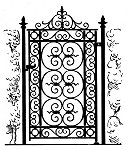 |
Bayliss, Jones and Bayliss
Victoria Works
Their 1938 Catalogue |
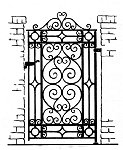 |
|
The exhibits in this section of the museum have been taken from a
catalogue of ironwork, fencing and gates issued by the company in 1938.
This is the kind of work for which the company is now best remembered
but it should be borne in mind that they made lots of other things as
well, many of which have been mentioned on the first page. |
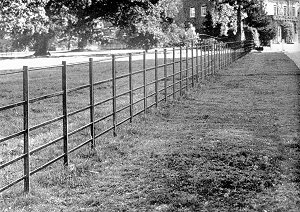 |
The catalogue starts with many pages of fencing,
mostly of a rather utilitarian type, though here their bar fencing
has been given a bit of glamour by its setting. Their products
included not only the posts for wire fencing but also the wire, in
solid, stranded or barbed forms, and also the straining bolts and
brackets. They also made woven wire fencing and chain link
fencing. And, of course, all the gates to go with the fences. |
| It is not a far cry from fencing to cattle pens,
especially if you are in agricultural centre like Wolverhampton.
These pens have been supplied to "most of the principal; markets in
this country" including Banbury, Taunton, Worcester, Barnsley,
Huddersfield, Uttoxeter, Tewkesbury, Witney, Aylesbury,
Kidderminster, Birkenhead, Reading, Carlisle and Hexham.
(note for visitors: yes, Wolverhampton, Barnsley and
Huddersfield really were agricultural centres). |
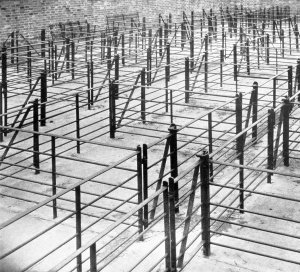 |
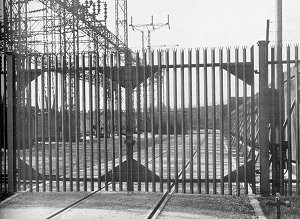 |
There are plenty more sorts of fencing, including
hurdles, railing for flower beds, deer park fencing, and so on.
Then we get back to the more prosaic stuff: the unclimbable railings
and the corrugated steel pale fencing, for which this is a gate.
These fencing and gates have been supplied to the Admiralty, the Air
Ministry and the Central Electricity Board. The photo shows
one of their stations. |
| This looks like the most basic sort of railing you
can get. But it isn't. It's Bayliss Jones and Bayliss
own "Nibal" fencing. The upper horizontal member is held
between nibbs on the vertical members and this, apparently, means
that thinner verticals give the same strength as thicker ones in
ordinary railings and allow the fencing to follow the contour of the
ground. |
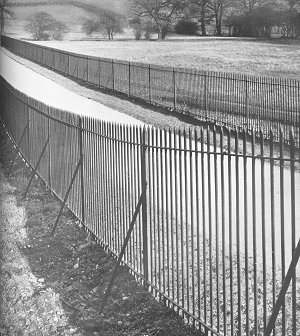 |
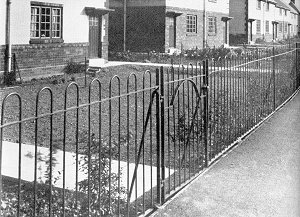 |
We now seem to have finished the ordinary fencing
because we now go on to "Special Railing, Gates and Architectural
Metal Work". But this is not so special that it does not allow
for these simple and cheap railings and gates "suitable for housing
schemes". |
| There are many designs for railings and gates for
villas and then ornamental stuff, including these gates of a type
"suitable for factories, breweries, etc".
When this page was first put on the site, we wrote: Who
and where were "Meco"?
|
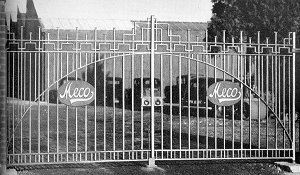 |
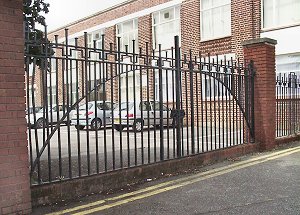 |
Such is the power of the Internet, and the
helpfulness of its users, that we now (2004) have answers.
Alan Knight tells us that Meco stood for Mining Engineering
Company and that it is in Bromyard Road, Worcester. The
company now goes under the name of Joy Mining and, Alan says,
"we have been at the forefront of underground technology for
nearly one hundred years". |
| Alan kindly provided us with these photos which
show, above, gates at the company's premises, very similar to
the ones in the catalogue. Those gates may have been
scrapped in the course of redevelopment. Around the corner
from the main gates is this pedestrian gate, clearly of the same
design. |
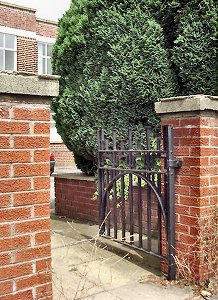 |
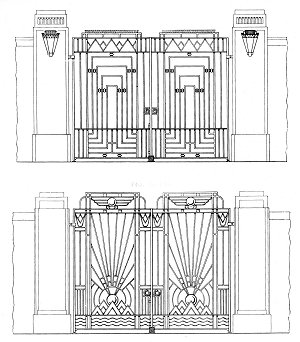 |
Ornamental gates come in great variety, in any
number of styles, including these archetypal art nouveau gates.
These appear to be offered as standard lines, rather than as
examples of one offs. The standard range includes wrought iron
gates with pictorial panels in outline where, presumably, the
customer could prescribe what the panel should depict. |
| There are gates "suitable for a public institution
or park" and, for example, these gates which are "suitable for
churches or tudor gothic buildings". Presumably the building
behind the gates shown here is in the "tudor gothic" style. |
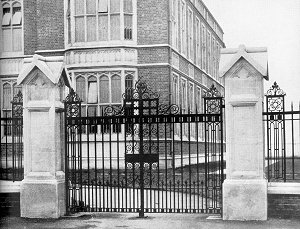 |
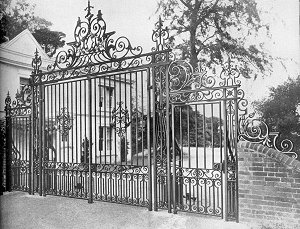 |
There are gates of many styles such as Italian,
English 18th century and Traditional English. These gates are
"suitable for a country house" ... |
| ... and these magnificent specimens are "in the
renaissance style, with vases and centre coats of arms etc in cast
bronze, suitable for a government building or palace". |
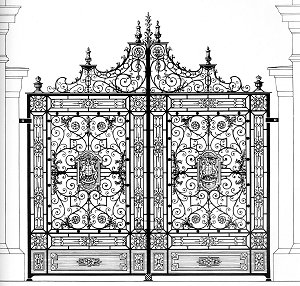 |
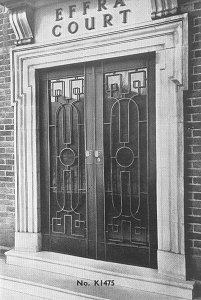 |
Bayliss Jones and Bayliss also made "Glazed
doors and decorative interior doors in wrought iron", of which
this an example on the left. And staircases, as on the
right. There is another example of their work of this kind
in the main entrance hall of Wolverhampton University. |
 |
 |
After pub signs, shops signs and weather vanes, and
bronze or copper lamps, we suddenly get to this period piece, under
the rubric "Canopies in metal and glass suitable for cinemas, shops,
hotels, etc.".
Does anyone recognise this "Broadway" cinema? |
So the curator wrote when this entry first appeared. Now
(November 2005) he is greatly obliged to Pete Griffin, who writes:
"I can tell you for certain that it was situated in Meir, Stoke on
Trent, and was on the crossroads where there is now a roundabout and a
tunnel for the busy A50. I used to attend this cinema regularly as
a child but it was demolished - sometime in the sixties, I would guess.
Only recently have I realised what a loss this was".
| We now come to "Interior Metalwork". These
domestic items are not so well known as products of this company, so
the Curator feels justified in showing a few.
The tall item to the left of the picture is said to be an
electric light standard. The other two items are glass
topped tables. |
 |
 |
All of these are radiator grilles - in those days
when central heating radiators were bulky objects which loomed large
and ugly in a room, there was even more cause for these cosmetic
panels than there is now. |
| The company also offers shelf brackets, umbrella
stands, and these fire hoods and fire dogs. This is the
only style available - a sort of medieval, sort of tudorbethan
style, that even today seems to be almost expected of ironwork. |
 |
 |
And these are fire screens. |
| After some church ironwork which, one suspects, was
all done to special order, and which includes altar rails, chancel
screens, entrance gates and lich gates, we come to what are called
"modelled works". These are cast in bronze or cast iron.
Presumably the moulds were made at the works from designs submitted
by architects. This example of a coat of arms is not
attributed. Does anyone know who had the cheerful motto "All's
well"? |
 |
 |
The final section of the catalogue, and therefore of
this exhibit, is titled "Miscellaneous iron and steel work".
In here there are sliding gates, level crossing gates, fire proof
doors, collapsible gates, cycle racks - and these guard railings,
which the Curator at least, seems to remember in many places,
especially seaside resorts on the proms. The catalogue does
not give a location but Kathy Amey has kindly told us that it is in
fact Bournemouth, with Hengistbury Head in the distance. Kathy
thinks the same railings are still there. |
| Then there are fire escapes and external staircases,
revolving turnstiles (are there any turnstiles that do not
revolve?), garden and park seats, garden arches, an ornamental well
head and "Tram and Bus Shelters". This one tells us that
Midland Red "buses leave here for Birmingham, Sutton Road, Catchem
End, Bewdley, Habberley Valley, Trimpley, Stourbridge and
Wednesbury". So: where was this shelter? |
 |
 |
Almost the last thing in the catalogue, and
certainly our last exhibit here, are "railing and gates for public
conveniences". The Curator does not know where this
underground ladies' lavatory is - and he doesn't much care. |
 |
Return to
the menu |
|

























